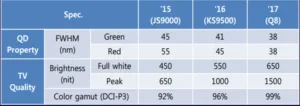Hyosook Jang from Samsung Institute of Advanced Technology (SAIT) started her presentation with an overview of the history of quantum dot development, starting way back in the 1980s. Samsung started showing prototypes of QLED displays in 2009 and commercialized its first TV in 2014.
She then described how they looked at a number of different Cadmium free materials to try to focus on the best one for commercialization. This included InP (QY 95%), ZnSe:Mn (QY 70%), CuInS2 (QY 90%). They eventually chose InP.
Jang then went through some of the quantum dot synthesis processes and the materials characterization steps that were required. Once the basic core/shell/ligand structure was developed in the lab, the team turned to mass production. For this, they partnered with Hansol Chemical for the synthesis of the quantum dots. Additional partners were then engaged to embed the quantum dots in resin, form it into sheets and add barrier films on both sides. In the panel discussion, Jang noted that they currently have capacity for Samsung premium TVs, but more capacity will be needed to extend QDs to mainstream products.
The company has now commercialized three generations of materials for their TVs, with the performance summarized in the table below. These are state of the art results.

